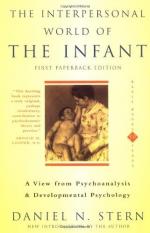
|
| Name: _________________________ | Period: ___________________ |
This test consists of 15 multiple choice questions and 5 short answer questions.
Multiple Choice Questions
1. __________ enables identifying what property belongs to which person, according to the author, which prevents the two core selves from getting confused.
(a) Teaching.
(b) Variety.
(c) Action.
(d) Nutrition.
2. According to the book, the ______ infant was thought to be connected to the social world.
(a) Objective.
(b) Observed.
(c) Small.
(d) Clinical.
3. There is little evidence showing that psychological insults and ______ at one age predict later clinical problems.
(a) Ideas.
(b) Attitudes.
(c) Development.
(d) Trauma.
4. Infants begin to learn that they can share subjective ________ with others and they begin to develop a working theory of how other minds work.
(a) Actions.
(b) Spaces.
(c) Experiences.
(d) Names.
5. Stern's developmental approach is seen to mirror most closely that of Mahler and ______.
(a) Bowlby.
(b) James.
(c) Klein.
(d) Winnicott.
6. The third organizing perspective produces a ______ during which time language points to knowledge of self.
(a) Domain of resource relatedness.
(b) Domain of physical relatedness.
(c) Domain of psychological relatedness.
(d) Domain of verbal relatedness.
7. _______ is developed when self and others acquire subjective mental states that can be recognized by the infant.
(a) Subjective relatedness.
(b) Objective relatedness.
(c) Intersubjective relatedness.
(d) Intrasubjective relatedness.
8. During the seventh to ninth month of development, infants are ________, but they can still create experiences that are shared.
(a) Pre-movement.
(b) Preverbal.
(c) Pre-visual.
(d) Pre-memory.
9. There is some debate about how the elements in question 10 relate to the sense of self including all of the following ideas except _______.
(a) Transformation of the sense of self.
(b) Obscuring an existing sense of self.
(c) Creating the sense of self.
(d) Revealing an existing sense of self.
10. The first sense of a self created in the first 8 weeks will remain active for _______.
(a) The first year of life.
(b) The first ten years of life.
(c) The first twenty years of life.
(d) The rest of life.
11. Infants begin to utilize various means in order to shift _______ and thus to create shared experiences, according to the author.
(a) Connection.
(b) Position.
(c) Attention.
(d) Movement.
12. Integration is experiences as an episodic ___________, according to Stern in his writing.
(a) Moment.
(b) Learning.
(c) Movement.
(d) Memory.
13. What type of psychology has NOT neglected the story of intersubjective relatedness, according to Stern?
(a) Psychoanalysis.
(b) Pop psychology.
(c) Academic psychology.
(d) Medical psychology.
14. According to the book, Erickson suggested several stages of development that included all of the following except _____.
(a) Autonomy.
(b) Industry.
(c) Trust.
(d) Sensory.
15. The self with the other comes about when the distinct ________ is integrated with the idea of the distinct other.
(a) Body.
(b) Thought process.
(c) Self.
(d) Headspace.
Short Answer Questions
1. The subjective self opens a domain of intersubjective relatedness which builds on the __________ self.
2. ________ is the idea that the infant's self concept is created by or at least altered by the narrative that she receives.
3. ___________ can regulate the infant's attention and engagement as a result of the idea of self-regulation that is happening to the infant and around them.
4. There have been several revolutions in _______ that have enabled the formation of new experimental paradigms.
5. Self-_________ becomes tied to the behaviors of the self-regulating other because they occur together.
|
This section contains 491 words (approx. 2 pages at 300 words per page) |

|




